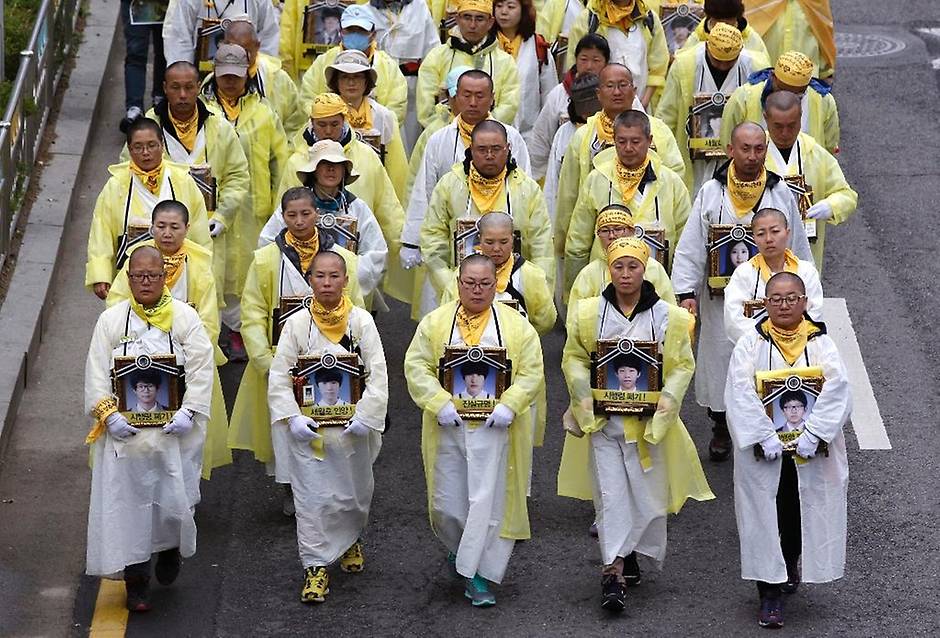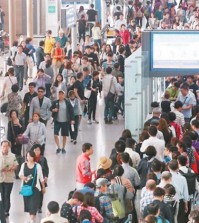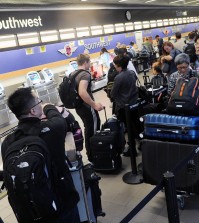- California Assembly OKs highest minimum wage in nation
- S. Korea unveils first graphic cigarette warnings
- US joins with South Korea, Japan in bid to deter North Korea
- LPGA golfer Chun In-gee finally back in action
- S. Korea won’t be top seed in final World Cup qualification round
- US men’s soccer misses 2nd straight Olympics
- US back on track in qualifying with 4-0 win over Guatemala
- High-intensity workout injuries spawn cottage industry
- CDC expands range of Zika mosquitoes into parts of Northeast
- Who knew? ‘The Walking Dead’ is helping families connect
9 in 10 S. Koreans doubt ferry sinking will inspire improved safety

Relatives carrying the portraits of the victims of a South Korean ferry sinking march during a rally demanding to salvage the ferry Sewol off the country’s southwest coast before starting the compensation process and thoroughly investigating of truth in Seoul, South Korea. A year ago, as South Korea writhed in grief and fury after more than 300 people, most of them school kids, drowned in the ferry sinking, it seemed things would never be the same. Yet not much has really changed as the first anniversary of the Sewol disaster is marked Thursday, April 16, 2015. (AP Photo/Lee Jin-man)
SEOUL, South Korea (AP) — A year ago, as South Korea writhed in grief and fury after more than 300 people, most of them school kids, drowned in a ferry sinking, it seemed things would never be the same. Yet not much has really changed as the first anniversary of the Sewol disaster is marked Thursday.
Experts believe it will be decades before any major shift is seen in widespread attitudes that make safety subservient to economic progress and convenience. Already there’s growing fatigue and frustration among citizens who see their government sliding back to business as usual, and a lack of accountability at high levels.
“I’m tired of talking about the Sewol because it’s obvious that nothing has changed because of it,” said Choi Chul-su, a 36-year-old office worker in Seoul. “It wasn’t supposed to be all about helping families overcome their grief. It was also about the government and society learning from the accident and executing those lessons. But nothing has been done there.”
The government blamed the country’s deadliest maritime disaster in decades on overloaded, poorly secured cargo and a botched rescue. But South Korea is divided over who’s responsible, and a planned investigation by a special committee has stalled amid wrangling over money and personnel.
Authorities, meanwhile, have come up with measures they hope will prevent similar accidents, including replacing the coast guard with a new massive safety agency and transferring authority to regulate shipping from a body funded by the industry to a publicly funded agency.
There’s skepticism that it will be enough, or that officials will handle future crises better. Since the sinking, the country has continued to see fatal accidents that expose lax safety standards and awareness:
— A month after the sinking, a fire set by an 81-year-old dementia patient killed 22 people at a hospital ward that wasn’t equipped with sprinklers.
— In October, 16 people watching an outdoor concert were killed when the ventilation grate they were standing on collapsed.
— More than 50 fishermen died in December in the frigid Bering Sea, in an accident police blamed on crewmembers keeping open a storage area to stash more of their catch despite high waves.
A public survey released last week showed nearly nine out of 10 South Koreans believe public safety hasn’t improved since last year’s sinking. The telephone survey of 1,000 adults, conducted by the Seoul-based Korea Research Center, has a margin of error of plus or minus 3.1 percentage points.
Motorcycles and scooters frequently zip along public sidewalks; cars regularly block fire hydrants. South Korea has the highest rate of fatal motor accidents and pedestrian deaths among developed-world nations forming the Organization for Economic Cooperation and Development, according to the Korea Transportation Safety Authority.
South Koreans working in large buildings can easily go an entire year without participating in a single fire drill, according to officials from the Ministry of Public Safety and Security. Failure to hold a fire drill at least once a year could result in a 500,000 won ($456) fine for the building’s owner, but ministry officials said the drills are frequently formalities involving only the building’s safety manager and a few others.
Some recent steps to improve public safety have been rolled back following complaints.
Officials in Gyeonggi province, which surrounds Seoul, cut the number of long-distance commuter buses that allowed passengers to stand in the aisles, but they then backtracked after many people complained that they missed their rides to and from work in Seoul.
South Korea’s attitudes toward safety were formed as it recovered from the decimation of the 1950-53 Korean War and rapidly rebuilt itself to become Asia’s fourth-largest economy.
“Safety is not just an issue of technology and government regulation, but also a matter of social behavior and morality, and this is not something that can be developed over a span of just a few years,” said Park Hee-Kyung, a civil engineering and disaster expert at the Korea Advanced Institute of Science and Technology in Daejeon. “It will be more like 30 to 50 years, and we are just at the beginning of the change.”
Safety measures South Korea has taken after the Sewol disaster include the hiring of outside experts to oversee the ship regulating body, requiring all cargo to be processed electronically and truck drivers to submit certificates on the weight of their cargo.
New laws set for July will also set up harsher punishment for crewmembers who don’t try hard enough to rescue passengers in need, such as possible lifetime prison sentences for captains. They also allow authorities to revoke licenses of ship operators found responsible for big accidents.
Lee Yun-cheol, 41, a co-head of a shipping company, said monitoring safety standards on passenger ships on domestic routes is “hapless and weak,” and more intensive checking and a larger number of inspectors are needed.
State prosecutors have arrested nearly 140 people, including Sewol crewmembers and ferry company employees, over allegations that they contributed to the sinking, and some have been sentenced to decades in prison. But many bereaved family members and their supporters demand a more thorough investigation and say higher-level officials have not been held accountable.
The parents of some student victims have been camping out at a main Seoul plaza for months in protest, drawing criticism from conservatives who say the parents are there illegally, and who want the country to move on from the disaster. In September, some counter-protesters gorged themselves on hotdogs and pizza in front of relatives of victims who were on a hunger strike.
“The bereaved families have lost their senses,” said conservative activist Park Wan-seok. “The Sewol incident was just a traffic accident that happened at sea.”
Some conservatives also oppose the families’ demands that the Sewol be pulled from the sea, saying money shouldn’t be spent on raising a civilian ship. Public surveys show a majority of South Koreans want the Sewol to be recovered, at an estimated cost of $91 million to $137 million.
Families of the victims recently rejected the government’s financial compensation plans, saying they want to first see the ship lifted from the seafloor and a thorough investigation into the sinking. Some other South Koreans also are frustrated by what they view as government inaction.
“The sinking of Sewol represented the failure of an entire system and culture,” said Lee Sang-joon, a 33-year-old Seoul resident. “But the government seems unwilling to carefully look into this.”
















Bereavement
September 16, 2017 at 8:41 AM
News – MSN